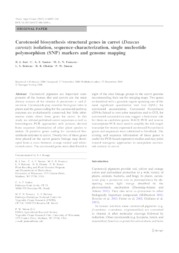Carotenoid biosynthesis structural genes in carrot (Daucus carota): isolation, sequence-characterization, single nucleotide polymorphism (SNP) markers and genome mapping.
Carotenoid biosynthesis structural genes in carrot (Daucus carota): isolation, sequence-characterization, single nucleotide polymorphism (SNP) markers and genome mapping.
Author(s): JUST, B. J.; SANTOS, C. A. F.; FONSECA, M. E. N.; BOITEUX, L. S.; OLOIZA, B. B.; SIMON, P. W.
Summary: Carotenoid pigments are important components of the human diet and carrots are the main dietary sources of the vitamin A precursors IX- and /3- carotene. Carotenoids play essential biological roles in plants and the genes coding for the carotenoid pathway enzymes are evolutionarily conserved, but little information exists about these genes for carrot. In this study, we utilized published carrot sequences as well as heterologous PCR approaches with primers derived from sequence information of other plant species to isolate 24 putative genes coding for carotenoid bio-synthesis enzymes in carrot. Twenty-two of these genes were placed on the carrot genetic linkage map developed from a cross between orange-rooted and white- rooted carrot. The carotenoid genes were distributed in eight of the nine linkage groups in the carrot genome recommending their use for merging maps. Two genes co-localized with a genomic region spanning one of the most significant quantitative trait loci (QTL) for carotenoid accumulation. Carotenoid biosynthesis cDNAs linked to root color mutations and to QTL for carotenoid accumulation may suggest a functional role for them as candidate genes. RACE PCR and reverse transcriptase PCR were used to amplify the full-length transcript for twenty expressed carotenoid biosynthesis genes and sequences were submitted to GenBank. The cloning and sequence information of these' genes is useful for PCR-based expression studies and may point toward transgenic approaches to manipulate carotenoid content in carrot.
Publication year: 2007
Types of publication: Journal article
Unit: Embrapa Semi-arid Region
Keywords: Caracterização, Carrot, Cenoura, Daucus Carota, Genoma, Mapeamento, Sequência
Observation
Some of Embrapa's publications are published as ePub files. To read them, use or download one of the following free software options to your computer or mobile device. Android: Google Play Books; IOS: iBooks; Windows and Linux: Calibre.
Access other publications
Access the Agricultural Research Database (BDPA) to consult Embrapa's full library collection and records.
Visit Embrapa Bookstore to purchase books and other publications sold by Embrapa.

